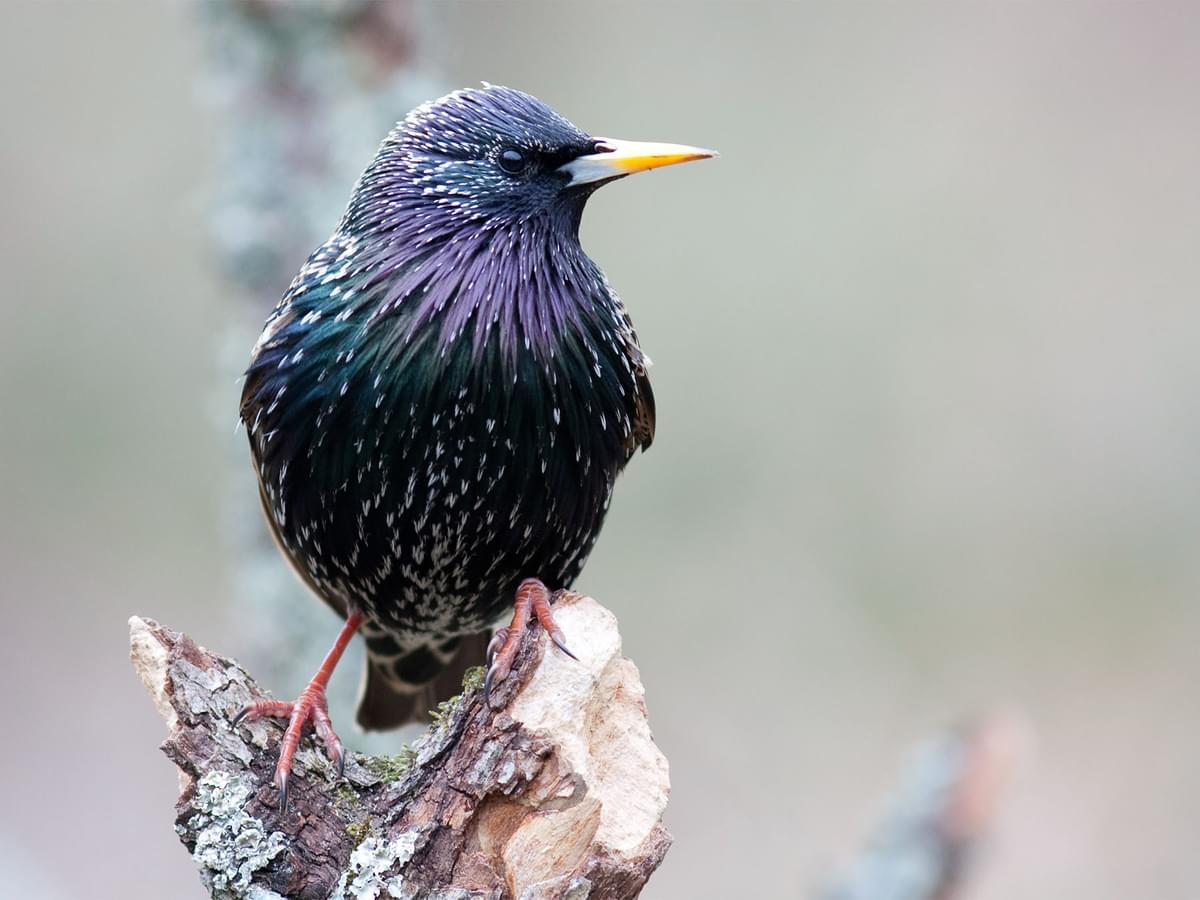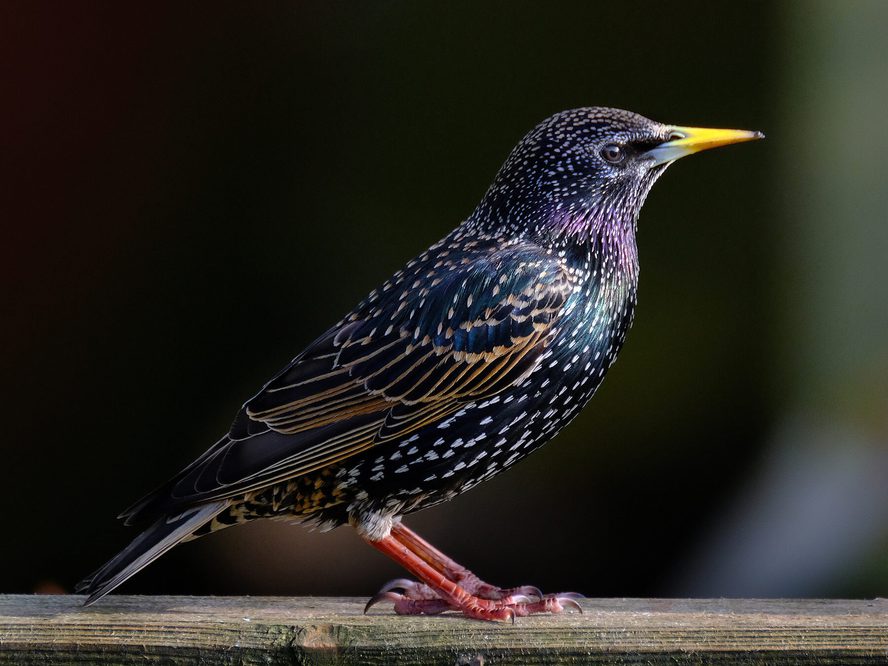Jump to Section
Attracting Starlings: Expert Advice on Bringing These Birds Closer
Last updated: 16 November 2023

Key takeaways
- Starlings will readily eat most foods offered, as they're not fussy. Consider offering seeds, nuts, fruit and vegetables.
- Offer suitable bird foods from a platform feeder, bird table, or directly on the ground.
- Once you have one Starling, be wary that many more will generally follow, so be prepared for a large flock.
- Starlings may put off other birds feeding at your feeders, as they're generally bigger and bolder.
There's more to discover. Continue scrolling for the full article below.
Starling murmurations are an impressive site, making swirling patterns across the sky at dusk on a summer evening. But starlings can be just as fascinating to watch close up, and feeding them in your backyard offers the opportunity to learn about their behavior as they interact with each other.
But what’s the best way to attract starlings and how can you get them to visit regularly? Keep reading and you’ll soon have dozens of these lively chattering birds eating out of your metaphorical hand!
Starlings are an easy species to attract to your garden, as they will readily eat any (or all) of the usual offerings at a backyard bird table or feeding station. And where one Starling feeds, a much larger flock will soon begin to gather.
Availability of suitable nesting spots for Starlings, including purpose-built nest boxes, will encourage a more permanent presence, at least during the breeding season, and topping up fresh water daily will also lead to a happy and healthy mob of lively, speckled backyard visitors.
Some researchers believe that playing music is an effective way of attracting and interacting with Starlings. Starlings are skilled mimics and one theory is that they respond positively to songs and music played to them.
So if you’re looking to attract starlings to your yard, and want to find out the best way of doing so, read on to learn about some ideas you can try out.

Starlings are an easy species to attract to your garden, as they will readily eat any (or all) of the usual offerings at a backyard bird table or feeding station
Providing Their Favorite Foods
Starlings are one of the least picky birds that could visit backyard feeders and are very easy to please, enjoying mealworms, suet, fat balls, fruit, and general scraps. Starlings are opportunistic feeders and in the wild will enjoy a diet that includes seeds, nuts, vegetables and fruit, and insects, caterpillars, worms, and larvae.
In spring and summer, when raising young, mealworms and suet are particularly popular as they provide the energy and protein needed to meet the feeding demands of hungry nestlings.
Feeding Starlings in Your Garden
Starlings are not early risers and tend to show up much later in the morning than other regular garden visitors and head off to roost relatively early in the evening. They are also fairly quick to move on once food has run out, heading off to their next feeding site rather than hanging around hopefully for more.
Feeding from platform feeders or bird tables, or directly on the ground are Starlings’ preferred feeding sites, but this doesn’t mean that they won’t attempt to access what’s on offer in hanging feeders.
It’s rare just to attract one or two Starlings, particularly in the winter and spring, as once one arrives to feed a noisy crowd won’t be far behind. And flocks of starlings mean a whole lot of droppings to clean. Keeping the feeding area clean is important to prevent the spread of disease, so using soapy water regularly to clean surfaces and feeders is recommended.

Pictured: A Starling collecting mealworms from a garden feeding station
Creating a Starling-Friendly Habitat
Starlings are cavity nesters and choose spots under the eaves of buildings, in chimneys, and in vents, as well as in hollows in trees and in artificial nest boxes. They may be observed to aggressively displace other nesting birds, particularly Bluebirds and Purple Martins in the United States, to take their cavities for themselves.
Although it's not ideal for many householders to have a family of noisy Starlings hatching out in your chimney, it’s helpful to remember that their nesting period is relatively short-lived and within around 3 weeks activity at the nest site will be drawing to a close as young will have fledged and moved onto alternative roosting spots.
Ensuring that there are suitable nest boxes available may deter starlings from nesting inside chimneys or under eaves.

Pictured: Starling feeding young at nest box. Starlings are cavity nesters and choose spots under the eaves of buildings, in chimneys, and in vents, as well as in hollows in trees and in artificial nest boxes
Using Sounds to Attract Starlings
Mozart was a firm believer in communicating with Starlings through music. He had a pet Starling and claimed it was able to accurately sing part of his Piano Concerto in G Major. Other anecdotal evidence exists of Starlings’ talents at mimicry, learning phrases and melodies that they have heard, including mobile ringtones and human speech.
Playing Starling song and monitoring the reactions of both male and female starlings has been tested by scientists to understand more about whether there is any scientific basis for claims that song helps attract female Starlings during the breeding season. Females were noted to be attracted to the playback, and investigated the source, while unexpectedly males were also drawn to the playback devices.
There is some ongoing debate over the ethical issues of using playback devices to study and attract birds, as it may cause confusion and unsettled behavior, so it’s probably better to leave this kind of study to experts who can safely monitor without any unnecessary distress.

Pictured: A Starling perching on a wooden fence. Mozart was a firm believer in communicating with Starlings through music
Understanding Starling Behavior and Patterns
If you’ve already begun to welcome starling visitors in your garden, you can’t have failed to notice just how quickly they feed. It can seem like you’ve no sooner topped up a feeder than it’s emptied again in an iridescent black squabbling frenzy.
Some dismiss this as ‘greedy’ behavior and are less than keen to encourage their presence. However, Starlings have evolved as a species to feed quickly with their flock before moving on to another site. It’s just starlings being starlings.
Starlings tend to arrive later in the day to feed and are one of the earliest birds to leave for evening roosts. They also won’t hang around in a backyard hopefully anticipating their next feed, as pigeons might.
They are notoriously noisy, bickering with their fellow starlings as they compete for food, but they are generally not aggressive to other species, and any tussles are short-lived.
Cautions and Considerations
Once you’ve attracted one starling, the chances are soon enough you’ll have a whole flock of chattering visitors descending on your feeders and squabbling noisily as they splash in your bird bath. You’ll soon notice that your feeders are rapidly emptied, particularly fat balls and suet, which are a particular favorite.
One way to slow down the need to top up your feeders and to give other, smaller birds a chance to eat too, is to use feeders with smaller mesh or to restock your feeding stations early in the morning as starlings tend to be relatively late arrivals each day.
Offering a safe and natural environment for starlings is to ensure no hazards are present in your garden, including potentially dangerous netting, pesticides or pet cats that might take an unwanted interest in any avian visitors.

If you’ve already begun to welcome starling visitors in your garden, you can’t have failed to notice just how quickly they feed
Summary
Providing food, water, and natural foraging opportunities are key ways to ensure Starlings visit your backyard and return mob-handed with their entire unruly flock.
Any food left out will be devoured, with mealworms, suet pellets, and fat balls being particular favorites. Don’t worry if they speedily polish off all that’s on offer, it’s just their nature to feed quickly and meticulously, causing a flurry of noisy activity in the process.
Music may also be effective in attracting Starlings to investigate your garden, but is possibly not the most reliable method, with food trumping all other tactics. Another key consideration is to ensure that your yard is free from any dangers or threats, such as the presence of cats that may not be especially tolerant of visiting starlings.
Despite being one of the most commonly recorded garden birds, global Starling populations are in decline due to a lack of available nesting sites and a shortage of natural prey.
While their noisy, scruffy, and seemingly greedy behavior may not make them a natural favorite of many, once you become familiar with their feeding habits and persistence at finding and hoovering up any scraps, you may begin to appreciate their strong characters and iridescent plumage as it shimmers through a spectrum of colors in natural sunlight.
FAQs
Can you befriend Starlings?
Urban Starlings are used to being around humans and are relatively tolerant of their presence. If you feed them in the same spot regularly, they can gradually become less timid and come to associate with you as a provider of food. However, it’s not advised to attempt to tame Starlings or allow them to become fully dependent on you for food as it may threaten their ability to survive in the wild.







